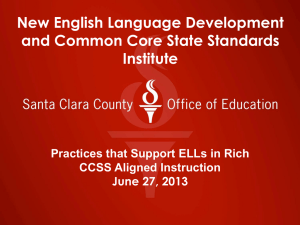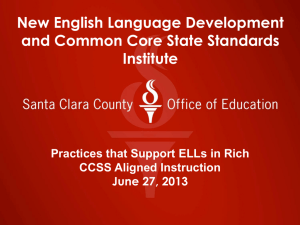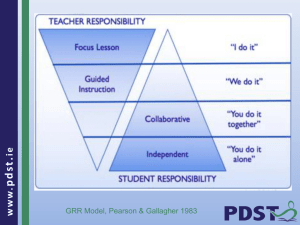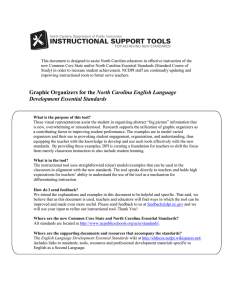Language Demands of the Common Core for ELLs and Implications for Instruction:
advertisement
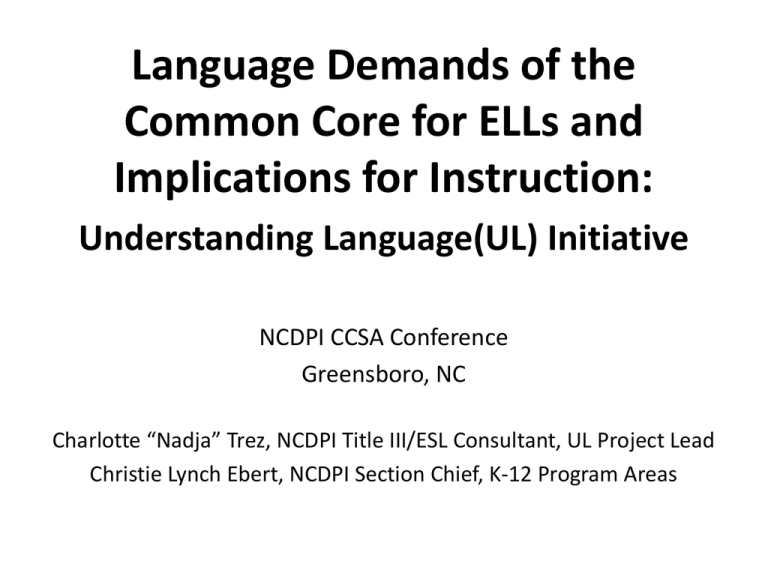
Language Demands of the Common Core for ELLs and Implications for Instruction: Understanding Language(UL) Initiative NCDPI CCSA Conference Greensboro, NC Charlotte “Nadja” Trez, NCDPI Title III/ESL Consultant, UL Project Lead Christie Lynch Ebert, NCDPI Section Chief, K-12 Program Areas The Common Core and NGSS Offers a New and Important Perspective on the Role of Language In Content Learning that Needs to be Supported by Instructional Shifts National Geographic: George Steinmetz Goals for the Understanding Language Initiative Engage in a healthy public dialogue around what the Common Core State Standards (CCSS) imply for English Language Learners (ELLs). Develop exemplars of what CCSS - aligned instruction looks like, to be used as strategic tools by districts (and others). Goals for the Understanding Language Initiative Develop a vibrant, inquisitive, engaging online community: Web: ell.stanford.edu Twitter: ELLStanford Facebook: Understanding Language You Tube: Understanding Language Goals for the session • Examine the critical role language plays in the new Common Core State Standards for English Language Learners (ELLs). • Identify specific teaching strategies that support ELLs’ access and success with authentic Common Core aligned complex texts. • Unpack the metacognitive processes teachers/educators need to support and reinforce ELL learning. • Explore ways to engage English Learners in high levels of discourse in Language Arts classrooms Major Shifts in Common Core Standards English Language Arts Regular practice with complex text and its vocabulary Building knowledge through content-rich informational texts Emphasis on reading, writing, and speaking that is grounded in evidence from the text Mathematics Provide opportunities for student access to the different mathematical (discourse) practices described in the CCSS Support mathematical discussions and use a variety of participation structures Focus on students’ mathematical reasoning, NOT on students’ flawed or developing language Science Developing and using models Constructing explanations (for science) and developing solutions (for engineering) Engaging in argument from evidence Obtaining, evaluating, and communicating information Cross-Cutting Foundations (ell.stanford.edu) • Language and the Common Core Standards (L. van Lier and A. Walqui) • What is the Development of Literacy the Development of? (G. Hull & E. Moje) • What Does Text Complexity Mean for English Learners and Language Minority Students? (L. Wong Fillmore & C. J. Fillmore) • Instruction for Diverse Groups of English Language Learners (A. Walqui & M. Heritage) What do the New Standards Imply? Focus on Language “Students can, without significant scaffolding, comprehend and evaluate complex texts across a range of types and disciplines and they can construct effective arguments and convey intricate and multifaceted information” (ELA student portraits, p. 7) Mathematically proficient students understand and use stated assumptions, definitions, and previously established results in constructing arguments. They make conjectures, and build a logical progression of statements to explore the truth of their conjectures” (Math practices, pp. 6-7) The New Standards… call for a high level of classroom discourse across all subject areas raise the bar for teaching and learning content make education more relevant to a globalized, interconnected, and highly competitive world. they call for (a) increased language capacities in combination with (b) content sophistication. promote multiple literacies. Understanding Language Content Understanding Language Mostly vocabulary, Grammar Old Paradigm Language New Paradigm Content Understanding Language Discourse Text (complex text) Explanation Argumentation Purpose Typical structure of text Sentence structures ΔVocabulary practices Language Realizing Opportunities for English Learners (Bunch, Kibler, Pimentel) ELLs should not be removed from the challenges set out in the standards, but rather supported in meeting them. ELLs can meaningfully participate in instruction through “imperfect” language. Instruction must build on – and build – students’ existing resources (L1, background knowledge, interests and motivations), precisely in order to expand them. Instruction must immerse students in meaning- making language and literacy activities with both micro- and macro- scaffolding (Schleppegrell & O’Hallaron, 2011) Theoretical and Pedagogical Shifts From a Conception of To an Understanding of • Language acquisition as an individual process • Language acquisition as a social process of apprenticeship that takes place in social contexts • Language as structures or functions • Language as action and use, subsuming structure and function (Ellis & Larsen Freeman, 2010; Van Lier & Walqui, 2012) • Language acquisition as implying the linear and progressive building on forms and structures, or functions, aimed at accuracy, fluency, and complexity • Language acquisition as non-linear and complex developmental process aimed at communication and comprehension • Use of simple and/or simplified texts • Use of complex, amplified texts for all students Theoretical and Pedagogical Shifts From a Conception of To an Understanding of • Traditional grammar as a starting point • Multimodal grammar to support students’ understandings of texts’ visual, spatial, gestural, audio, and linguistic meaning • Identification of discrete structural features of language • Language is purposeful and patterned to accomplish content specific rhetorical tasks • Use of activities that pre-teach the content, or simply “help students get through texts” • Use of activities that scaffold students’ development and their autonomy, so that the knowledge gained is generative in nature and applicable to novel learning contexts The theory of action Share units that can serve as exemplars for how CCSS standards are supported for ELLs; Pilot units with careful observation of the challenges and successes of implementation; Support schools and districts in their identification of: ◦ existing materials that support the new standards, and in ◦ the development of units that support the new standards Connect the content standards and English Language Development standards, with instructional and assessment implications. A Pilot ELA Exemplar “Persuasion Across Time and Space: Analyzing and Producing Complex Texts” A Unit Developed for the Understanding Language Initiative by WestEd’s Teacher Professional Development Program Unit Authors: Aida Walqui, Nanette Koelsch, and Mary Schmida In Collaboration with Understanding Language’s English Language Arts Working Group: George C. Bunch (Chair), Martha Inez Castellón, Susan Pimentel, Lydia Stack, and Aida Walqui Persuasion Unit Illustrates how ELA CCSS can be used to deepen and accelerate the instruction of ELLs in middle schools. Is based on the notion that ELLs develop conceptual and academic understandings as well as the linguistic resources to express them simultaneously, through participation in rigorous activity that is well scaffolded (Walqui & van Lier, 2010) LESSON 2 Persuasion in Historical Context: The Gettysburg Address •Gettysburg Address LESSON 1 Advertising in the Contemporary World: An Introduction to Persuasive Texts •Can you live with dirty water? UNIT Persuasion Across Time and Space: Analyzing and Producing Persuasive Texts LESSON 5 Putting it Together: Analyzing and Producing Persuasive Text •The Girl who Silenced the World for Five Minutes LESSON 3 Ethos, Logos, & Pathos in Civil Rights Movement Speeches •MLK “I have a dream” •Robert Kennedy “On the Death of Martin Luther King” •George Wallace “The Civil Rights Movement: Fraud, Sham, and Hoax “ LESSON 4 Persuasion as Text: Organizational, Grammatical, and Lexical Moves in Barbara Jordan’s All Together Now •Barbara Jordan “All Together Now” Lesson 2: Persuasion in Historical Context: The Gettysburg Address • Demonstrates the tripartite nature of lessons: Preparing Learners, Interacting with Texts, Extending Understanding. • Build schema about the time, place, and the political context of Lincoln’s famous speech through the reading of informational text. • Discover how cohesive and coherence ties work together to create meaning. • Example: In Our Own Words: the Gettysburg Address is recreated by individual, groups, and the whole class to make a cohesive and coherent contemporary text. 3 Moments in the Reading of the Gettysburg Address PREPARING LEARNERS •Jigsaw Project: Era Envelope •Clarifying Bookmark •Base Group Share •Wordle Partner Share with Round Robin Task 1 Task 2 Task 3 Task 4 INTERACTING WITH TEXT •Close Reading •Reading in Four Voices •Literacy Devices Dyad •Wordle, Part II Task 5 Task 6 Task 7 Task 8 EXTENDING UNDERSTANDING •Vocabulary Review Jigsaw •In Our Own Words Task 9 Task 10 Preparing and Scaffolding Learning • Era Envelope (Background readings and photos) • Jigsaw and “focus chart” for building essential background knowledge (“sourcing”) • Clarifying Bookmark (to support students in reading the background material and to develop metacognitive skills for reading) • Viewing Photos for discussion • Wordle with roundtable discussion on images that the words provoke Era Envelopes – Scaffolding • There are three different ways to scaffold the Era Envelopes for different language needs: Option 1: Implementation of the task with minimal scaffolding – groups work independently Option 2 : Implementation of the task with moderate scaffolding – groups jigsaw the readings Option 3: Implementation of the task with maximal scaffolding – teacher works through the readings with students Era Envelopes – Moderate Scaffolding Jigsaw Reading 1.Students sit in base groups of three based on the number of texts. They count off from 1 to 3. 2.All the 1’s meet together, all the 2’s meet together etc. Give each group a reading. 3.Each group works together to read and answer the questions for their reading. 4.Students use the Clarifying Bookmarks to discuss the reading. Clarifying Bookmark Era Envelope: Discussion 1.After completing the Jigsaw Reading and their section of the handout on page 8, students return to their base groups. 2.Students take turns sharing responses text-by-text, adding to or revising responses as needed. 3.Students discuss what was written about each reading using the Clarifying Bookmark. Photo Task • Each student picks a photo from the envelope. • Students take turns talking about their photo. • Who is in the photo? • Who is not in the photo? Why are they missing? • What else is in the photo? • Where do you think the photo was taken? Why do you think so? • When was the photo taken? How can you tell? • The group picks one photo and completes HO #7. • Together they write a caption for the photo and post on the wall. Era Envelope and Photograph Response • Minimal and moderate scaffolding: Groups review photos and select one for further analysis • Maximum scaffolding: Teacher selects and guides response to one photo Close Reading A complex text presents: • Informational density • Textual references • Elaborated nouns •One solution? Read one sentence at a time, (a short, powerful one), unpacking and making visible its complexity Close Reading: The Gettysburg Address In Our Own Words • Partners are assigned one or two sentences from The Gettysburg Address to translate into modern English. • Sentences are transferred to strips of paper. • Speech is reassembled. • Teacher leads discussion of consistency in tone and voice. • Students revise sentences and repost. Word Clouds: Wordle Students work with a partner to: Pick two or three words that jump out at you. Discuss images or ideas come to mind when you think of the words Round Robin Each student in the group shares at least one word and image/idea associated with it. Do not discuss or comment until everyone has shared. Interacting with the Text Close reading with guided questions Reading in Four Voices Literacy Device Matrix (in dyads) Wordle, revisited (What images do you associate with the words now? Look for variations of similar words (e.g. dedicate and dedicates – together the most frequent word “family” in the speech Dedicate matrix The Gettysburg Address – Multiple Readings Listen to a version of the Gettysburg Address Read the Gettysburg Address in Four Voices Close reading with guided questions Partner reading of the text for Literacy Devices Group Analysis – In our own words Interacting with the Text Sample Guiding Questions for Close Reading Literacy Device Matrix Work with a partner to find examples of repetition in the Gettysburg Address. The first example has been done for you. Example: New nation Any nation This nation Literacy Device Answer Key Repetition New nation, that nation, any nation So conceived, so dedicated We are engaged, we are met, we have come We cannot dedicate, we cannot consecrate, we cannot hallow Of the people, by the people, for the people Extending Understanding Vocabulary review jigsaw In our own words Vocabulary Review Jigsaw Groups of four Label a piece of paper “The Gettysburg Address”. Write numbers 1-12 in a list. Each table should have a set of 4 cards. Each person gets a card. Person with card A calls out a number, teammates find that number on their paper. “A” reads the sentence with that number Next “B” reads the sentence with that number Then “C” reads the sentence with that number Finally “D” reads the definition In Our Own Words There are ten sentences in the The Gettysburg Address Partners are assigned one sentence from The Gettysburg Address to translate into modern English Sentences are transferred to strips of paper. Speech is reassembled. Teacher leads discussion of consistency in tone and voice Students revise sentences and repost Persuasion Across Time and Space: Analyzing and Producing Complex Texts” Invites students to participate in processes of apprenticeship that lead them from being novices to developing increasing levels of expertise while they build their agency and autonomy. You can download the Unit at Ell.stanford.edu What do we do for Beginning English Learners? This unit is for English Learners in ELA classes who are at the intermediate or above proficiency levels. Beginners are recommended to be placed in appropriate ESL classes. One size does not fit all! ELD standards apply in these cases. Expectations should be based on those standards for each student’s correct PROFICIENCY level. English Learners can be given the same assignments, however product expectations should be based on the proficiency level of each student. Scaffolding is key to student success. Discussion Questions What shifts did you see evident in the unit? What would be necessary for teachers to move in this direction for English Learners? How can initiatives like Understanding Language be of help? Charlotte-Mecklenberg Teacher Comments During PD, I thought the selections would be too difficult for ELs. Now I see that with good scaffolding and repeated readings ELs can access difficult text. I now understand the need for spiraling texts, instead of doing unconnected lessons. My teaching has changed forever. Student comments during interviews They said they understand more when they work in groups. They unit wasn’t too difficult. They felt they could do all the activities. Math Resources Exemplars available for elementary, middle, and high school; however only the elementary materials will be piloted. Developed by Understanding Language, under the leadership of Prof. Judit Moschkovich of UC Santa Cruz, and with assistance from a team of math and language experts. Provider of P.D. for these materials: Grace Coates Elementary Sample Annotated Lesson Roger’s Rabbits Grade 4, Operations and Algebraic Thinking Adapted from Roger’s Rabbits Copyright by Mathematics Assessment Resource Service (MARS) 2008. Roger’s Rabbits Core Ideas Rogers Rabbits asks students to identify whether finite sequences of number follow given rules and extend those sequences according to those rules. Roger’s Rabbits Common Core State Standards for Mathematics Grade 4, OA 3, 4 3. Use the four operations with variable numbers to solve problems. 4.Gain familiarity with factors and multiples Generate and analyze patterns.* *Note: We are not requiring students to infer or guess the pattern, but to generate a pattern from a given rule and identify features of the given pattern. Roger’s Rabbits CCSS for Mathematical Practice SMP #’s 1, 3, 6, 7, 8. 1. Makes sense of problems and persevere in solving them 3. Construct viable arguments and critique the reasoning of others 6. Attend to precision 7. Look for and make use of structure 8. Look for and express regularity in repeated reasoning The Annotations The annotations provide a variety of structures that support student-to-student dialogue. The strategies engage students in clarifying meaning, determining common agreements, justifying their thinking. As they solve this multistep problem, students develop academic and content-specific language that demonstrates precision in communicating their thinking/ideas to others. Roger’s Rabbits CCSS for ELA / Literacy Standards 1, 4, 7, and 2 Key Ideas and Details: Refer to details and examples in a text when explaining what the text says explicitly and when drawing inferences from the text… Craft and Structure: Determine the meaning of general academic and domain specific words /phrases in a text relevant in gr.4 subject area. Integration of Knowledge and Ideas: Interpret information presented visually, orally, or quantitatively (charts, graphs, diagrams, timelines, animations or interactive elements on Web pages) Speaking and Listening: Paraphrase portions of a text read aloud or information presented in diverse media and formats, including visually, quantitatively, and orally. Educators Words / Experiences “I will use this in my class… thank you.” “I found this most helpful in making the CCSS (in math and language) more real and doable with my ELL students.” “The annotations seemed like a lot to do…I realize that it is also a way of thinking about my lessons….” I always look for ways to keep my students focused on talking about the work at hand. These (and the questioning strategies) have changed how I perceive student talk during class. “I’ve been giving my kids vocabulary lists that were “out of context” forever. Thank you for helping me see why kids weren’t making connections. (the look-up-the- word kind)” Questions and Answers CMS Pilot Experience Teachers as Leaders building capacity to continue leading the way for language, literacy, and learning in the classroom UL Curriculum Writing Project CMS Piloting the Units Statewide (English Language Arts and Mathematics) • ELA (Middle Grades) – Persuasion across Time and Space: Analyzing and Producing Complex Texts • Math (Elementary Grades) – A set of resources that discuss relevant language and supports the participation of ELLs in Mathematical discussions NC UL Project Timeline October 3, 2013 Informational Webinar May – August 2014 or TBD Application Process and Pilot Participants Selection September 2014 Or TBD Four (2 x 2) Day Face-to-Face Training (East & West regions) TBD MOOC modules provided by Stanford University TBD Race to the Top Regional Support via RESA sessions TBD Expansion and Sustainability Planning Pilot Participants English Language Arts (Grade 7) 4 LEAs/Charters per each region (Grade 7 ELA team + ESL teacher + EC teacher + administrator + academic coach/facilitator) Math (Grade 4) 4 LEAs/Charters per each region (Grade level TBD + ESL teacher + EC teacher + administrator + instructional coach/facilitator) Questions and Answers References Ellis, N. & Larsen-Freeman, D. (Eds.) (2009). Language as a complex adaptive system. Language Learning, 59, Supplement 1. van Lier, L., & Walqui, A. (2012, January). How teachers and educators can most usefully and deliberately consider language. Paper presented at the Understanding Language Conference, Stanford, CA. Walqui, A. & van Lier, L. (2010). Scaffolding the academic success of adolescent English Learners. A pedagogy of promise. San Francisco: WestEd. Walqui, A., & Heritage, M. (2012, January). Instruction for diverse groups of English language learners. Paper presented at the Understanding Language Conference, Stanford, CA. Contact Information Charlotte “Nadja” Trez Title III/ESL Consultant NC Department of Public Instruction nadja.trez@dpi.nc.gov Christie Lynch Ebert K-12 Program Areas Section Chief NC Department of Public Instruction christie.lynchebert@dpi.nc.gov
